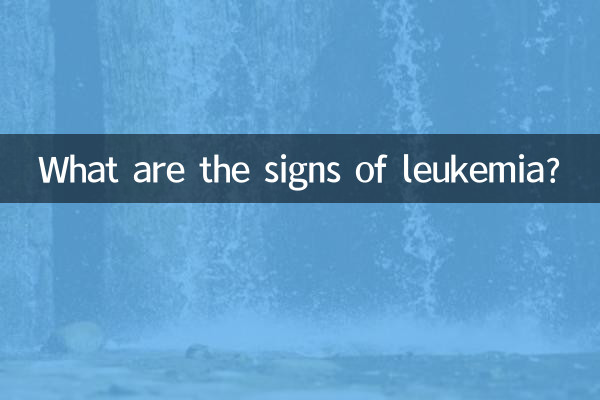What are the signs of leukemia?
Leukemia is a malignant tumor of the hematopoietic system, and early symptoms are often easily ignored. Knowing the signs of leukemia can help with early detection and treatment. The following is a summary of leukemia-related topics and precursor symptoms that have been hotly discussed on the Internet recently. It combines medical data and patient cases to provide you with structured data and analysis.
1. Common symptoms of leukemia precursors

Early symptoms of leukemia vary, but here are some of the most common:
| symptom | describe | Possible reasons |
|---|---|---|
| persistent fatigue | Feeling extremely tired even after resting | Anemia or immune system abnormalities |
| recurring infections | Frequent colds, fevers, or infections that are difficult to cure | Abnormal white blood cell function |
| abnormal bleeding | Nosebleeds, bleeding gums, or skin bruising | Thrombocytopenia |
| bone or joint pain | Particularly common in pediatric patients | bone marrow dysplasia |
| swollen lymph nodes | Swollen lymph nodes in the neck, armpit, or groin | abnormal lymphocyte proliferation |
2. Leukemia-related topics that have been hotly discussed on the Internet recently
In the past 10 days, the following leukemia-related topics have sparked widespread discussion on social media and news platforms:
| topic | heat index | Main discussion points |
|---|---|---|
| Early signs of childhood leukemia | 85 | How parents can identify abnormal behavior in their children |
| Leukemia and environmental pollution | 78 | Decoration pollution, radiation and other risk factors |
| Progress in new targeted therapies | 92 | Breakthrough therapies such as CAR-T cell therapy |
| Dietary recommendations for patients with leukemia | 65 | Nutritional support program during treatment |
3. Characteristic precursors of different types of leukemia
Leukemia is mainly divided into two categories: acute and chronic, with different precursors:
| type | major precursors | rate of progress |
|---|---|---|
| acute lymphoblastic leukemia (ALL) | Fever, bone pain, swollen lymph nodes | Rapid deterioration within weeks |
| Acute myeloid leukemia (AML) | anemia, bleeding tendency, infection | weeks to months |
| Chronic lymphocytic leukemia (CLL) | Asymptomatic or mild fatigue | Slow development over several years |
| Chronic myeloid leukemia (CML) | Splenomegaly, night sweats, weight loss | months to years |
4. High-risk groups that require special attention
The following people should be highly alert to the possibility of leukemia when they have relevant symptoms:
| high risk groups | risk factors | Recommended screening frequency |
|---|---|---|
| People with a family history of leukemia | genetic susceptibility | Annual physical examination + blood routine |
| long-term exposure to chemicals | Exposure to benzene, formaldehyde, etc. | Routine blood examination every six months |
| Those who have received radiotherapy/chemotherapy | therapy-related leukemia | Regular follow-up after treatment |
| People with certain genetic diseases | Down syndrome | Monitoring guided by specialist doctors |
5. How to distinguish common symptoms from precursors of leukemia
Many leukemia precursors are similar to common diseases, but they have the following characteristics to be alert to:
1.long lasting: Common cold fever usually subsides in 1-2 weeks, but leukemia-related fever often persists or recurs.
2.Symptom combinations occur: When symptoms such as anemia, bleeding, and infection occur at the same time, the possibility increases significantly.
3.Conventional treatment is ineffective: Recurrent infections that are ineffective in antibiotic treatment, or anemia in which iron supplementation is ineffective.
4.progressive aggravation: Symptoms gradually worsen rather than alleviate.
6. Expert advice and preventive measures
1.Regular physical examination: Routine blood examination is the most basic screening method, and abnormal indicators should be further examined.
2.Pay attention to body changes: Especially unexplained symptoms that last for more than 1 month.
3.Reduce risk factors: Avoid long-term exposure to chemicals such as benzene, and provide adequate ventilation after the new house is decorated.
4.Seek medical attention promptly: When multiple danger signs appear, you should see a hematology department as soon as possible.
Although leukemia is scary, with the advancement of medicine, many types of leukemia can be treated with good results. The key lies in early detection and standardized treatment. We hope that through the structured data and analysis of this article, we can help everyone better understand the precursors of leukemia and protect their health.

check the details

check the details